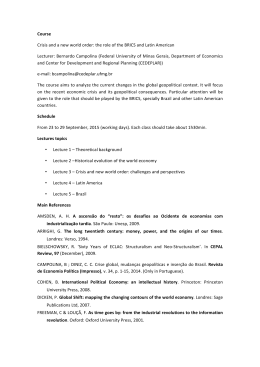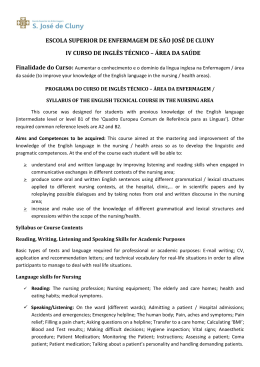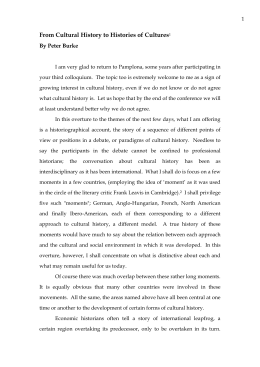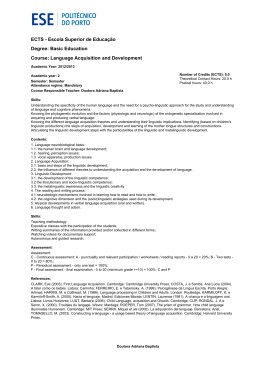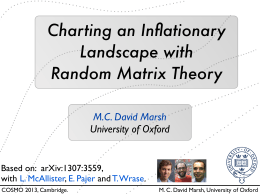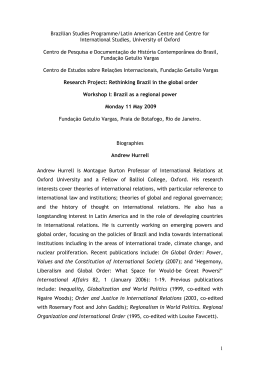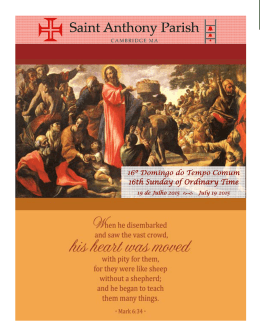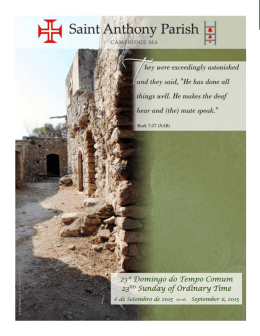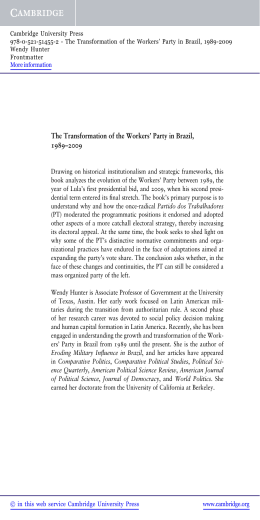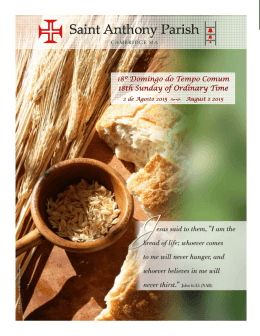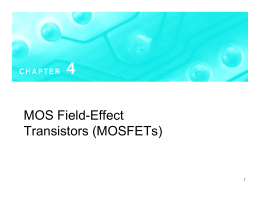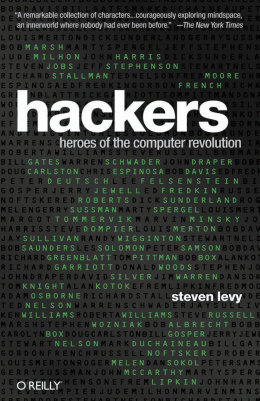The State of Play: English Literary Scholarship and Criticism in a New Century Daniel Carey Over the course of its history, English studies might reasonably be described as the undisciplined discipline. Rather than adhering narrowly to a particular mode of critical practice, the field has been marked by a restless, acquisitive approach to other areas of study, seeking relationships over time with anthropology (e.g. the work of Lévi-Strauss or Clifford Geertz), psychology (notably Freud and Lacan), history, sociology, politics (especially Marxist-inflected), or philosophy broadly defined (in the growth of critical theory through exchanges with phenomenology, structuralism, and subsequent developments associated with post-structuralism and postmodernism). The possibilities have opened out further with the simultaneous expansion and abandonment of the canon, which has made it harder to say, in advance, what set of texts or contexts might constitute the ‗proper‘ field of literary research. In part this has happened due to the impact of New Historicism, Cultural Studies, and influential work on gender and sexuality, but the pattern is too pervasive to have emerged solely from these significant influences. In 1992, when Stephen Greenblatt and Giles Gunn surveyed critical developments in English, they framed the moment as one of crisis in which the breakdown of traditional approaches created various possibilities that nonetheless threatened the integrity of the discipline. ‗Literary studies‘, they stated, ‗are in a period of rapid and sometimes disorienting change‘, which called into question the ‗cohesiveness of the field as a whole‘ (GREENBLATT and GUNN, 1992, p. 1-3). Their alarmist tone may have accurately described the mood in the early 1990s or sensationalised it for effect, but the predicament they described has, over time, become the norm. 1 Each generation of critics must seemingly invent a new series if not of critical approaches then at least of texts on which to work. At one level this represents a growth of sophistication and realisation of potential, but at another it speaks to the competitive dimension of scholarship which requires new entrants to put their forebears out of business. The real danger may not be incoherence, then, but rather a creeping logic of intellectual capital in which consumption and reassignments of value occur at a bewildering pace. On the whole, however, my sense of current trends confirms the existence of disciplinary strength rather than decadence. Accommodations have been struck between criticism and scholarship which have created better balances and the potential for greater durability, as the thraldom of theory has receded and respect for historical research has resurfaced. This essay is an attempt to set out some of the ways in which this appears to be occurring. After a discussion of the subject matter of criticism, I will look at emerging ways of organising study, and finally the disposition of various established critical approaches. The orientation of my examples around the early modern through the eighteenth century and Romanticism reflects my own Cadernos de Letras (UFRJ) n.27 – dez. 2010 http://www.letras.ufrj.br/anglo_germanicas/cadernos/numeros/122010/textos/cl301220100danielcarey.pdf 17 preoccupations, but I have attempted to give, where possible, a wider account that also takes in medieval studies, Victorian criticism, and the twentieth century. 2 I The dominant critical orientations at present remain largely contextual. This is true whether the privileged context is one of politics, economics, social history, gender relations, empire, material culture, intellectual history, or law and legal discourse. English literature, in short, is rarely treated on its own as an independent or hermetic subject of analysis, but must find its way into a contextual relationship that defines its meaning and significance. To begin with the relationship between law and literature, it is clear that investigations of this conjunction have developed considerable scope and significance in recent years. 3 For scholars of the early modern period, in particular, the demands of this subject of study are considerable, given the complexities of the court system, the varieties and extent of legal authority, and the emergence of equity as a concept and legal recourse through the Court of Chancery in the period. Yet there is no doubt, as critics such as Andrew Zurcher and Bradin Cormack have shown in different ways, that law and literature became intertwined, not merely through the careers, training, and experience of major figures like Edmund Spenser, but also through the capacity of literature to examine the relationship between sovereign power and the law, making it a site of potential resistance and commentary (ZURCHER, 2007; BRADIN, 2008). Subha Mukherji, Lorna Hutson, and B.J. Sokol have pointed to a different connection between these two areas; they have concentrated on drama as the locus for assessing the cultural impact of new conventions of evidence, testimony, and probability (MUKHERJI, 2006; HUTSON, 2007; SOKOL and SOKOL, 2003). At stake in these discussions is not only an understanding of cultural influences bearing on English writers, but the larger issue of whether Foucault‘s analysis of modes of discipline and punishment can be properly applied an English context. Hutson and Cormack have contended that it is not. Although Foucault‘s authority may have been challenged in this setting, other recent work nonetheless suggests an ongoing fascination with criminality as a topic of investigation, which owes something to the seismic shifts in critical thinking brought about by Foucault‘s exploration of power and normativity. Literary scholars have, among other things, brought attention to the generic forms in which stories of crime publicly circulated. Srinivas Aravamudan‘s account of rogue pamphlets shares this interest while leading to a theoretical account (mediated by both Foucault and Derrida) of the rogue as a figure of resistance to sovereignty. At the same time, Aravamudan observes that ‗What we witness in the seventeenth and eighteenth centuries is the rise of something like rogue capitalism, the daily swindling and conniving that takes place in multiple creative ways alongside notions of political domination and subjection through force or fraud‘ (ARAVAMUDAN, 2007, p. 460). There has also been a striking resurgence in critical work on issues of gender, particularly apparent in accounts of criminal biographies of women (e.g., ROSENTHAL, 2006). While scholarship in this vein on Defoe‘s Moll Flanders has had a long history, the discussion of gender and expansion of textual range serves to expose not only prevailing social conventions but also intriguing possibilities for agency, in some ways consonant with a Foucaldian emphasis on transgression and the construction of social identity, and in some ways a reflection of a different intellectual and critical pedigree associated with feminist criticism. 18 If the study of law and literature represents one area of research which has broken down disciplinary oppositions in favour of a mutually informing analysis, there has been another, perhaps more challenging assault on the divide between literature and science. The preoccupations of American New Criticism in the 1950s with the internal coherence of literary forms or I.A. Richards‘s description in the 1920s of poetry as offering ‗pseudo-statements‘ with no engagement with the real might be seen as different ways of marking off literature from the increasingly dominant position of the sciences. This strategy may have made its own sense at the time, but the notion of literature and science as antithetical has been abandoned in contemporary scholarship. Books like Darwin’s Plots by Gillian Beer (and her essays collected in Open Fields: Science in Cultural Encounter) set an important precedent for this reevaluation, which has rapidly progressed in recent years (BEER, 1983, 1996; see also CHRISTIE and SHUTTLEWORTH, 1989). The ‗two cultures‘ are now seen as feeding into one another in areas as diverse as medicine, physics, and technology. In Einstein’s Wake: Relativity, Metaphor, and Modernist Literature (WHITWORTH, 2002), for example, Michael Whitworth has attempted to chart the impact of Einstein‘s special theory on the literary imagination, through studies of such major figures as Woolf, Eliot, Lawrence, and Wyndham Lewis. 4 In eighteenth-century studies, evidence of a productive critical encounter between literature and science appears in the considerable attention given to the definition of the human – exploiting a paradox in the period which celebrated the concept of human nature while trading in grotesque images of the body and monstrosity, of which Swift‘s anatomy of human nature in A Tale of a Tub is the most famous example (his narrator remarks: ‗I have some time since, with a world of pains and art, dissected the carcass of human nature, and read many useful lectures upon the several parts, both containing and contained, till at last it smelt so strong I could preserve it no longer‘). Erica Fudge has examined the early modern period more generally in order to interrogate the separation between human and animal in a series of intriguing studies (FUDGE, 2006, 2000).5 These questions have been brought forward historically by Stefani Engelstein in Anxious Anatomy: The Conception of the Human Form in Literary and Naturalist Discourse (ENGELSTEIN, 2008). Among Renaissance scholars, the burgeoning study of relations between literature and science includes Elizabeth Spiller‘s account of ways of ‗making knowledge‘ (an important theme in the work of one of the leading historians of science, Simon Schaffer), which looks at figures such as William Harvey and William Gilbert alongside Philip Sidney and Edmund Spenser. The discussion of Margaret Cavendish in the book is apt given Cavendish‘s participation in both the worlds of natural philosophy and literature (SPILLER 2004). Henry Turner has elsewhere made a bold case for rethinking the Renaissance stage by studying practical applications of mathematics and geometry and their effect on imaginations of space and literary form (TURNER, 2006). In Romantic criticism, the pattern of linking science and literature continues, not that this should surprise us given the era saw the publication of Frankenstein (1818). At the same time, the period in general has often been regarded, in its attachment to the irrational and opposition to certain strands of Enlightenment, as hostile to science, but a richer relationship and dialogue has been shown in the work of Maureen McLane. McLane‘s study integrates contemporary developments in the human sciences, especially related to population as understood by Malthus and others, with Romantic authors‘ reconceiving of the human species (McLANE, 2000). The emphasis on poetic diction as conditioned by the speech of ordinary men, in Wordsworth‘s system, takes on a different significance when considered in this light, 19 as does the peculiar verbal dexterity of Frankenstein‘s monster, condemned to live beyond a human community while possessing the politeness of speech appropriate to it. The public profile of these issues generally has recently been raised by Richard Holmes‘s The Age of Wonder: How the Romantic Generation Discovered the Beauty and Terror of Science (HOLMES, 2008). Technology and material culture come together in fascinating ways in Isobel Armstrong‘s Victorian Glassworlds: Glass Culture and the Imagination 1830-1880 (ARMSTRONG, 2008). This study is exemplary in the way that it combines attention to new methods of industrial production with their aesthetic impact, yielding close readings of contemporary poetry in particular. 6 A book of this kind by a major critic makes obvious the degree to which texts are now taken to be inseparable from context rather than existing as privileged entities that transcend their circumstances of conception. In the process, what an earlier mode of criticism might have relegated to the status of a footnote has become the focal point of the investigation. One of Armstrong‘s topics, Crystal Palace and some of the displays there at the first ‗World‘s Fair‘, has been the subject of a separate edited volume, Victorian Prism, which explores architecture, floor plans, exhibits, and even landscaping to assess the cultural significance of this epochal event and entity. Here the structure itself is a textual site, in effect, whose meanings become accessible through literary analysis. 7 II The movement away from the high abstractions of theory towards a materiality of the written is nowhere more apparent than in the growing centrality of book history in literary scholarship. Major, multi-volume projects such as The Cambridge History of the Book in Britain (6 vols), A History of the Book in America (5 vols), History of the Book in Canada (3 vols), The Edinburgh History of the Book in Scotland (4 vols), and The Oxford History of the Irish Book (5 vols) have brought together hosts of scholars working on periodical culture, production and distribution, marketing, illustration, and reading practice over vast historical periods. 8 The framing of these inquiries within national traditions is notable given the degree to which such an orientation has elsewhere broken down.9 To some extent this represents a survival of collaborative research dedicated to subjects of abiding national pride, following, in this case, in the wake of the French efforts which led to the remarkable Histoire de l’edition française (MARTIN and CHARTIER, 1982-86). Some of these developments can be traced to a resurfacing of an unembarrassed attachment to the empirical, but a more theoretical foundation can be found in pioneering work by Jerome McGann and the late D.F. McKenzie. They altered the direction of traditional bibliography, with its tendency to fetishize the literary object and the notion of authorial control or intention, in favour of what McKenzie called the ‗sociology of the text‘ (McKENZIE, 1986) or in McGann‘s phrase ‗social text‘ (McGANN, 1991, p. 21), which gave as much attention to circulation and reception as the author‘s intention. 10 One can still admire the heroic work done to reconstruct printing practices associated with Shakespeare‘s First Folio and the various bad quartos without being beholden to notions of an ideal copy text. 11 To that extent, the McGann and McKenzie model is much more accommodating and opens out towards a wide range of publishing contexts for potential sources of research and explanation. 12 By contrast, it is difficult to imagine, under the older protocols, how any sense could be made of pursuing an author‘s intention with the 20 work of William Burroughs and others dedicated to a ‗cut up‘ technique which deliberately flouted intentionality (HARRIS, 2006, 2007; BURROUGHS, 2006). The richness of this field as a whole would be hard to overstate, which ranges from studies of the relationship between print and manuscript culture, to marginalia (SHERMAN, 2007; JACKSON, 2001); the development of Enlightenment networks of printing integrating a colonial system (SHER, 2006); the emergence in Romanticism of reading publics or what William St. Clair has called the ‗reading nation‘ (ST. CLAIR, 2004); and the study of literary modernism in the context of magazine publication (SCHOLES and WULFMAN, 2010). At the more theoretical end of the spectrum, the influence of Gérard Genette‘s Paratexts has been widely felt (GENETTE, 1997), which has opened up an array of new areas of attention in contemplating the book as a constructed object (e.g. SMITH and WILSON, forthcoming). The likelihood is that this development will continue as the internet and electronic book reshape the ways in which we think about publishing practice and print as a medium (JOHNS, 2010; DARNTON, 2009; McGANN, 2001). It is also worth noting the degree to which scholarship in this area is marked by contributions from both historians and literary specialists whose work has become inseparable, in practice, rather than constituting antithetical approaches that are mutually disdained. The once familiar divergence between history and literature has been revisited in the move towards intellectual history by a range of English scholars. The prestige and influence of figures like Quentin Skinner or J.G.A. Pocock has been widely felt beyond their disciplines for many years, and their example has encouraged particular attention to relationships between literature and political theory, especially among early modern scholars. An intriguing mixture of scholars from the two disciplines, including Skinner, David Armitage, Stephen Greenblatt, and Cathy Shrank, have contributed to Shakespeare and Early Modern Political Thought (ARMITAGE, CONDREN and FITZMAURICE, 2009). The complementary methodologies of Skinner and Pocock, privileging rhetoric and language, already suggested the potential for contributions by critics attuned to the literary, as we see in the case of Victoria Kahn and her discussion of the crisis of political obligation during the English Civil War (KAHN, 2004). Medievalists have long engaged with these issues, of course, but the inflection of work has changed, for example in Paul Strohm‘s Politique: Languages of Statecraft between Chaucer and Shakespeare (STROHM, 2005), with its subtle attention to political rhetoric. This is only part of the story of the embedding of intellectual history within literary study, as issues of epistemology, moral philosophy, and the new science have become the subject matter of English scholarship. These questions were by no means neglected in the past, but renewed attention has been given to major figures such as Milton and Shakespeare: Milton has been discussed in relation to topics as diverse as his engagement with toleration or his understanding of angels, while Shakespeare‘s connections with contemporary natural history and the sceptical tradition have been extensively explored.13 In a special issue of South Central Review on Shakespeare and science (MAZZIO, 2009), for example, literature and science become mutually constitutive, rather than the text occupying a foreground in which, on occasion, annotations emerge to illuminate contemporary vocabularies of botany or other matters of natural history. Two wide-ranging volumes have appeared which see literature in relationship, above all, to moral philosophy – Christopher Tilmouth‘s Passion’s Triumph over Reason: A History of the Moral Imagination from Spenser to Rochester (TILMOUTH, 2007) and Jonathan Lamb‘s The Evolution of Sympathy in the Long 21 Eighteenth Century (LAMB, 2009). Other recent work by literary scholars has engaged with literary history not as a supplement to the study of literature but more as an area of concern in its own right, such as Rhodri Lewis‘s work on universal languages (LEWIS, 2007) or my own study, Locke, Shaftesbury, and Hutcheson (CAREY, 2006) which investigates questions of diversity and how they were interpreted by philosophers from 1660-1800. The cultural turn in literary and philosophical analysis has created the space in which a wider set of subjects has come under discussion. One field within the broad area of intellectual history, the history of economic thought, has been well established in literary circles, as the work of James Thompson, Sandra Sherman, Catherine Ingrassia, Colin E. Nicholson, Patrick Brantlinger, and Marc Shell testifies. 14 Of course the subject is broader than merely the intellectual conception of credit as an extension of the circulating medium, and includes social relations and pressures associated, for example, with the suspension of cash payments by the Bank of England in 1797. Here too the integration of scholarship from literary and historical sources is apparent, judging from the work and influence of Craig Muldrew (MULDREW, 1998) or the interesting contribution made in Deborah Valenze‘s The Social Life of Money in the English Past (VALENZE, 2006). Fiction as a site of representation of financial transactions has been studied, as well as the more theoretically charged question of how fictions are credited in the period, such that the ‗fictional‘ nature of credit economies has been, to an extent, already normalised within the domain of the literary (as Thompson had already shown). New books by Catherine Gallagher and Mary Poovey and have extended the discussion of political economy and its relationship to literature firmly into the Victorian period (GALLAGHER, 2005; POOVEY, 2008; see also ANTHONY, 2009; WAGNER, 2010). Intellectual history represents one avenue for considering the importance of these questions, but social and economic history has also attracted literary scholars. David J. Baker‘s On Demand shows how major authors in the period from 1590 to 1620 understood the increase in consumption and demand for goods that marked the period (BAKER, 2010). Once again, the economic has a kind of primacy and literature is contextualised by seeing its development of new rhetorical strategies to represent and satirise an emerging social phenomenon. Growing attention to the problems of globalization has led others to investigate literature‘s place in, or response to a world system. Jyotsna Singh‘s A Companion to the Global Renaissance (SINGH, 2009) constitutes one such attempt, drawing on contributions from numerous scholars, to resituate the Renaissance within webs of signification created by consumption of exotic goods and the political and economic relations that made this possible. Episodes in the history of taste, such as Chinoiserie, are certainly well known, but the focus on a global framework reestablishes the ambition by European states to compete for these goods while examining their cultural impact. Attempts have been made, for example by Anna Neill, to investigate these issues in relation to Swift and Defoe (NEILL, 2002), while a more substantial contribution has come in the form of Felicity Nussbaum‘s edited volume The Global Eighteenth Century (NUSSBAUM, 2003), which notably combines the work of leading literary scholars and historians side-by-side. One could still perhaps argue that there is no overriding theory of globalization at work here; rather, the global becomes a setting in which Renaissance or eighteenth-century literature is placed contextually. 22 III The study of cross-cultural exchange, conflict, and representation, pioneered in different ways by Edward Said, Peter Hulme, Stephen Greenblatt, and Mary Louise Pratt, has grown in a number of directions over the last decade. Current scholarship, notably from Jonathan Burton, Bernadette Andrea, Nabil Matar, Gerald Maclean, Daniel Vitkus, Matthew Dimmock, and Emily Bartels has devoted greater attention to the near east and Islamic world – fuelled in part by current political, economic, and military crises, and the renewed attention this has encouraged to an older history of conflict.15 Suzanne Conklin Akbari has done similar work for the medieval period (AKBARI, 2009). For some scholars, literature remains privileged as a site of representation, especially in the context of contemporary drama (see DIMMOCK, 2005, VITKUS, 2003, ORR, 2001; KERMODE, 2009; NIAYESH, 2009; BURTON, 2005). But others have integrated substantial discussion of sources that once would have been regarded as non-literary, such as travel accounts and captivity narratives. Tim Fulford‘s Romantic Indians, while considering Coleridge and Southey‘s American interest in Pantisocracy, focuses to a considerable extent on less familiar moments of cultural encounter in the New World. A similar orientation is also apparent in Kate Flint‘s The Transatlantic Indian 1776-1930 (FLINT, 2008), which considers canonical literature but largely concentrates on reading a variety of materials like travelling shows, popular fiction, and neglected accounts by indigenous peoples who came to Britain. 16 For an earlier period, Robert Markley has looked at the Far East, analysing major figures like Milton and Defoe but also more obscure travel accounts and diplomatic reports, while Ros Ballaster‘s approach is especially attuned to issues of gender (MARKLEY, 2006; BALLASTER, 2007). The subject of slavery, which has sustained the work of literary scholars as much as historians for many decades, has in its own way been brought into closer contact with the study of travel and cultural difference. This has occurred not simply through greater concern with slavery as a system of cultural representations, but also with the philosophical traditions that inflected accounts of human nature. One of the most interesting contributions is Lynn Festa‘s Sentimental Figures of Slavery in Eighteenth-Century Britain and France (FESTA, 2006), which addresses the emergence of sentimentality at the moment of European colonial consolidation in the New World. She engages with the question of how sentiment created the conditions for potential identification with subjects oppressed by political and economic hardship, but how unevenly distributed it remained. Postcolonialism continues to provide some of the most influential critical terminology in these discussions, as questions of hybridity, mimicry, or native resistance have expanded beyond specific historical circumstances to become paradigms of a kind, applied readily to other areas or historical eras. 17 An ongoing contest has taken place in postcolonialism between a Marxist tradition of reading which emphasized issues of class and modes of production, and the postcolonial model which privileges race, sovereignty and cultural domination together with economic interests predicated on exploitation and expropriation. Evidence of this interpretive tension appears in the subtle rivalry played out between Said and Raymond Williams in Said‘s Culture and Imperialism (SAID, 1993), but it has not receded, it seems to me, from view (see LAZARUS, 2002). A different challenge faced in this field is the (paradoxical) need for a more cosmopolitan postcolonialism, 23 one which is not tied to British Empire studies but which conducts research in a broader, comparative context across Europe‘s imperial ventures. From critics of postcolonialism, the objections against it routinely advanced are of a kind that had little purchase in the era of poststructuralist dominance, namely that texts are appropriated for a payoff arranged in advance, or that only a thin layer of historical evidence is considered in making arguments with major implications. Whatever the truth of these charges, they indicate that theory no longer occupies quite the sovereign position it once did, even if the prestige of authorities like Homi Bhabha and Gayatri Spivak remains undiminished. IV Following on from my consideration of some of the different topics on which literary research is conducted and the ways in which it is done, some remarks are appropriate about what might be called the organisation of study. The intellectual investment in certain kinds of periodization is being challenged. This is evident in the desire to lengthen periods in question; the long fifteenth century has been joined by the long nineteenth century, as companions to the well-established long eighteenth century. At the same time, movements that stand as period markers have been pluralised, an indication of discomfort with the notion that unitary incarnations of ideas or movements existed. For the same reason, the ‗Renaissance‘, always a loaded term, has been replaced for the most part by the ‗early modern‘ (in part under the influence of historical scholarship). Perhaps more significantly, the trend has been for movements that have traditionally been kept separate from one another to overlap and interact, as for example the Victorian and modern, the medieval and Renaissance/early modern, or Enlightenment and Romanticism. 18 In short, the adequacy of traditional divisions is under question. Nonetheless, it is worth pointing out that the profession still works within traditional time periods and recognisable sub-disciplines, particularly when it comes to making academic appointments. Whatever directions individuals take in their published work, they still have to present themselves, for the most part, as experts within the parameters of familiar categories. There is a risk, then, of introducing changes that are more terminological than substantial or that are undermined, equally, by professional demands and resistances within the curriculum to disturbance. But a potentially more durable development appears in the reorientation of research around issues of the geographical. 19 Franco Moretti‘s Atlas of the European Novel 1800-1900 (1998) provided a model for how to address some of these questions and he has continued it in the massive compilation of essays on the novel published in an Italian edition and English translation (MORETTI, 2001-2003, 2005).20 Jenny Mander‘s collection Remapping the Rise of the European Novel (MANDER, 2007) likewise provides an alternative geography for thinking about the development of the novel form. In Archipelagic English (KERRIGAN, 2008), an ambitious study not confined to a single literary genre, John Kerrigan has reoriented English literature around the study of its multiple locations and associated ethnic and political contexts, examining the ways in which English writing did not emerge from a settled national identity or indeed from a metropolitan center.21 Such a conviction has long been held in Romanticism, but it has been taken back in time by Kerrigan in a study pegged, interestingly, to historical dates of the accession of James I and the Act of Union joining Scotland and England. Literary scholars have taken their lead from historians in another geographical setting by adopting the model of the Atlantic World. Atlantic historians, from Bernard 24 Bailyn to Jack Greene, Philip Morgan and David Armitage, have set a provocative agenda for the historical profession, studying not only the transit of peoples (both free and unfree), but also markets and unifying ideologies within an Atlantic frame. Not all of Atlantic history‘s normative dimensions have been taken on board by literary specialists, which is just as well, but they have been engaged all the same by the challenge of situating literature in a wider domain of shared systems of communication and transportation, ideological assumption, and cultural aspiration. 22 The Atlantic model also serves to break up existing periodizations of English literature. The lengthy scope, for example, of Laura Doyle‘s Freedom’s Empire: Race and the Rise of the Novel in Atlantic Modernity, 1640-1940 (DOYLE, 2008) is telling. But it is also, significantly, the need to address the story of slavery and race that requires an alternative form of geography and narrative. 23 V In thinking more generally about critical orientations it is clear that the moment of ‗high theory‘ that predominated in the 1980s and 90s has given way to analyses that rely more obviously on history for their intellectual resources, particularly evident in a movement toward interdisciplinary contexts. This is not to say that one can afford to be theoretically unaware or to reintroduce a naive positivism about historical evidence, but rather that theoretical position taking does not have to be rehearsed with quite the same degree of earnestness as before. There is a risk, of course, in setting up an opposition, inadvertent or otherwise, in which attention to the contextual becomes equivalent to doing ‗historical‘ research, while ‗theoretical‘ accounts alone do the work of ‗textual‘ analysis. In fact, the impact of historical investigation and a movement beyond traditional disciplinary boundaries is precisely that it unsettles received theoretical assumptions and reorients our perspective on the meanings and cultural significance of texts. At the same time, the ability to read texts reframes the historical, in a more productive engagement between these domains of inquiry. There are always pitfalls, inevitably – like the tendency to outsource theory in some versions of book history, which allows for unreconstructed empirical investigation while ‗theory‘ is supplied from somewhere else, or the more crude appropriations of history for polemicizing purposes in certain kinds of postcolonial scholarship. Even as the status of ‗theory‘ has been reconsidered, one can hardly overlook the fact that one legacy from the 80s and 90s remains the privileging of certain star theorists whose work exerts a kind of inexorable force over scholarship. Something of a revolving door is at work, with a number of the older luminaries, like Derrida and Habermas, succeeded by Bruno Latour, Slavoj Žižek, Judith Butler, and Giorgio Agamben (with the latter engaging heavily with Carl Schmitt and leading others to do so in his train). Here evidence remains of an ongoing separation of styles between ‗Anglo‘ scholarship and American, with the US continuing to favour more overt expressions of critical authority and the UK making its debts to history more conspicuous. The case of Derrida is complicated because his reputation and influence were of such magnitude that it has made it difficult to pronounce his name without encountering semi-audible groans. Yet the sheer range of topics on which he wrote means that his complex thought represents an ongoing resource, as we see, for example, in Cary Wolfe‘s work on animal rights and ‗posthumanism‘ (WOLFE, 2009, 2003). 25 The exceptional range and quality of work on women‘s writing is undiminished, evident in ongoing archival work to recover texts and the production of scholarly editions as well as major monographs and syntheses like those of Susan Staves, Susan Wiseman, or Karen O‘Brien. 24 In literary histories more generally the unsettling of old biases and configurations of the canon has meant that it is less likely for women authors to be treated in separate chapters but rather for their work to be discussed in a fully inclusive fashion. The attention to gender and sexuality likewise testify to unfinished projects of cultural transformation, whether in analyses of masculinities in different periods and the reconceptualising gender under the rubric of performativity, or the critical force of queer theory (see TRAUB, 2002; MARCUS, 2007; EHNENN, 2008). Depending upon how one regards it, New Historicism has either ceased to have any critical hold or has carried on undisturbed as the dominant way of doing business. The paradox has everything to do with how narrowly or expansively one defines it as a critical practice. Thus, on one account, New Historicism has proved an enduring way of engaging with texts: under its banner, literature and context have been thoroughly integrated – it is not a question of foreground and background but of what Stephen Greenblatt once referred to as the ‗circulation of social energy‘ (GREENBLATT, 1988). The canon has expanded and the range of possible juxtapositions between texts has multiplied accordingly. The discourse model remains pervasive, while cultural forms are understood as ‗representations‘, not as transparent imitations of a pre-given reality, inflected by ideological interests governing their production. On a more narrow account of New Historicism, however, it is clear that critics have distanced themselves from a number of its working assumptions. The emphasis on rupture between periods (as between medieval and early modern); the reductive account of power in which all cultural practices are subsumed under its effects; the attachment to anecdote; and subversion and containment as an explanatory model – none of these strategies of argument have proved especially enduring in terms of critical methodology. A similar story could be told about the legacy of Foucault who cast such a long shadow over what might be called the first phase of New Historicism‘s analysis of literature and culture. His pervasive presence is still felt in many areas, notably in discussions of sexuality, but the relentless account of power has released some of its grip over scholarship. 25 One of the weaknesses of New Historicism was its relative inability to cope with the topic of religion, other than as an adjunct to power. Thomas More was discussed in Renaissance Self-Fashioning, but not as a believer, and there was little likelihood of Richard Hooker making an appearance on the pages of that book. Religion has now resurfaced as a topic of research, in studies of sermon culture, conversion, and other forms of religious experience. 26 The need to engage with women‘s history and literary production has in part stimulated this reassessment, as devotional writing and forms of piety are investigated in the recovery of neglected or marginalised figures and traditions. Of course, for medievalists it was never possible to exclude the religious from critical attention; Barbara Newman‘s God and the Goddesses: Vision, Poetry, and Belief in the Middle Ages is one of the most impressive accounts of these issues in recent years (NEWMAN, 2003). To conclude, the diversity of English scholarship at the moment is apparent, but if we want to indicate the larger project which unifies these inquiries, then the history of culture might serve as an appropriate expression. Cultural Studies would do equally well, although the political crucible in which that movement was formed does not always correspond to the variety of ways, many of them less politically driven, in 26 which research is now conducted. The arguments over the canon, which once focused on its ideological load-bearing capacity, have been sufficiently successful that they are no longer rehearsed but have been internalised as custom and practice within an expanded literary studies. The energy and interest of current scholarship seems to derive, above all, from its responsiveness to interdisciplinary contexts. What from one perspective might be seen as a weakness – the tendency of scholars to accept that serious work is going on somewhere else, whether it is in the sciences, history, politics, or the law – is actually a source of strength. The most inviting and suggestive studies tend to combine many of the issues and orientations I have described above in novel ways, such as Julie Crawford‘s Marvelous Protestantism: Monstrous Births in Post-Reformation England, which brings together history of science with gender, religion and print culture, or Pamela Cheek‘s Sexual Antipodes, which examines travel, colonialism, sexuality, and globalization in the eighteenth century (CRAWFORD, 2005; CHEEK, 2003). The somewhat arid moment of theory-driven criticism, often bedevilled by the problem of determining whether something amounted to a good Derridean reading or an average or unaccomplished one, has made way for scholarship that can at least be assessed with reasonable confidence regarding whether it makes a contribution or merely circulates familiar ideas and issues. Daniel Carey NATIONAL UNIVERSITY OF IRELAND, GALWAY Notes 1 They were struck by the diversity of projects and critical idioms in the study of British and American literature that came not from a unified center but from various sources, ‗some of which lie outside the realm of literary study altogether and intersect one another often at strange angles‘. Michèle Lamont, likewise, has recently asserted the destabilising effect of interdisciplinarity in How Professors Think: Inside the Curious World of Academic Judgment (LAMONT, 2009). 2 Insofar as I engage with the twentieth century, my account does not explore the impact of postmodernism on contemporary critical thought, nor criticism devoted to film and other media. 3 Some of this attention may testify to the legacy of a certain kind of intellectual impetuosity evident in Stanley Fish‘s essays on legal subjects collected in There’s No Such Thing as Free Speech, and It’s a Good Thing Too (FISH 1994). Recent indications of these ongoing interrogations can be found in KRUEGER, 2010; KERTZER, 2010; SLAUGHTER, 2007; CHENG, 2004. 4 Nicholas Dames has recently taken the discussion in a new direction by considering the physiology of reading in the Victorian period, arguing for a less settled or relaxed understanding of reading occasions, which historicises social practice while drawing on research in neuroscience (DAMES, 2007). 5 In contemporary philosophy see AGAMBEN, 2003. 6 For a related study of Renaissance literature, see KALAS, 2007. 7 BUZARD, CHILDERS and GILLOOLY, 2007. For a historian of science‘s consideration of related matters, see SECORD, 2004. 8 McKENZIE, McKITTERICK and WILSON, 1999-; FLEMING and LAMONDE, 2004-7; HALL, 2000-2009; FINKELSTEIN and McCLEERY, 2007. 9 This is not to say that the nation as a category has ceased to interest scholars – the contrary is true as we see in SHRANK, 2004. By contrast, scholarship on thematic questions has tended to transcend the nation, and in any event these inquiries occur not in order to bolster national pride but with a decided critical edge (e.g. CHEAH, 2003). 10 At the same time, this approach has not been troubled by the kinds of sceptical reflection on the disappearance of the text once promulgated by Stanley Fish (FISH, 1980). 11 Something of a backlash appears in historian Michael Hunter‘s Editing Early Modern Texts: An Introduction to Principles and Practice (HUNTER, 2006). 27 12 Editions at least partly on these principles include the Oxford Milton, and Cambridge editions of Swift, Conrad, and Lawrence. 13 See, for example, ACHINSTEIN and SAUER, 2007; RAYMOND, 2010; BELL, 2003; BERTRAM, 2004; HAMLIN, 2005. 14 See SHERMAN, 1996; SHELL, 1995; INGRASSIA, 1998; THOMPSON, 1996; NICHOLSON, 1994; BRANTLINGER, 1996. 15 ANDREA, 2007; BURTON 2005; BARTELS, 2008; MATAR, 2005; MACLEAN, 2004, VITKUS, 2003; DIMMOCK, 2005. 16 MATAR, 2009, and MUZAFFAR and SUBRAHMANYAM, 2007 have added new possibilities by translating works by Indian and Arabic authors describing travel experience and visions of Europe. 17 CAREY and FESTA, 2009 is an attempt to think about these questions in relation to the Enlightenment. 18 See, e.g., STROHM, 2005; COOPER, 2004; FOWLER, 2003; LOVEZZO, 2006; WALLACE, 2009. 19 This approach complements attention to cross-cultural issues, and fulfils a demand by Edward Said for marking what he called the ‗geographical notation‘ of literature in Culture and Imperialism: ‗Yet most cultural historians, and certainly all literary scholars, have failed to mark the geographical notation, the theoretical mapping and charting of territory that underlies Western fiction‘ (SAID, 1993, p. 58). 20 See also his study Graphs, Maps, and Trees: Abstract Models for a Literary History (MORETTI, 2005). 21 See also on this subject SCHWYZER and MEALOR, 2004. 22 See, e.g., a number of recent edited collections: MANNING and TAYLOR, 2007; KOSTROUN and VOLLENDORF, 2009; HACKEL and KELLY, 2007. 23 An interesting precedent is ROACH, 1996. 24 STAVES, 2006; WISEMAN, 2006; O‘BRIEN, 2009. 25 We can trace the emergence of reservations at least as early as 1992 with Louis Montrose‘s perhaps unexpected indictment of Foucault: ―I find this aspect of Foucault‘s social vision—his apparent occlusion of a space for human agency—to be extreme. In other words, my intellectual response is that his argument is unconvincing, and my visceral response is that it is intolerable‖ (MONTROSE, 1992, p.392). Nonetheless, the history of sexuality remains an undiminished preoccupation of scholarship, although an alternative or adapted model associated with Agamben‘s notion of bare life has also emerged. 26 See, e.g., MURRAY, 2009; SULLIVAN, 2008; KEARNEY, 2009. References ACHINSTEIN, S; SAUER, E. (Eds.). Milton and toleration. Oxford: Oxford University Press, 2007. AGAMBEN, G. The open. Man and animal, trans. Kevil Attell. Stanford: Stanford University Press, 2003. ANDREA, B. Women and Islam in early modern English literature. Cambridge: Cambridge University Press, 2007. ANTHONY, D. Paper money men. Commerce, manhood, and the sensational public sphere in antebellum America. Columbus: Ohio State University Press, 2009. ARAVAMUDAN, S. Subjects/sovereigns/rogues. Eighteenth-Century Studies, v.3, n.40, p. 457–465, 2007. ARMITAGE, D.; CONDREN, C.; FITZMAURICE, A. (Eds.). Shakespeare and early modern political thought. Cambridge: Cambridge University Press, 2009. ARMSTRONG, I. Victorian glassworlds. Glass culture and the imagination 1830-1880. Oxford: Oxford University Press, 2008. BAKER, D. J. On demand. Writing for the market in early modern England. Stanford: Stanford University Press, 2010. BALLASATER, R. Fabulous orients. Fictions of the East in England, 1662-1785. Oxford: Oxford University Press, 2007. BARTELS, E. Speaking of the Moor. From Alcazar to Othello. Philadelphia: University of Pennsylvania Press, 2008. 28 BEER, G. Darwin’s plots. Evolutionary narrative in Darwin, George Eliot, and nineteenthcentury fiction. London: Routledge & Kegan Paul, 1983. BEER, G. Open fields. Science in cultural encounter. Oxford: Clarendon Press, 1996. BELL, M. Shakespeare’s tragic skepticism. New Haven: Yale University Press, 2003. BERTRAM, B. The Time is out of joint. Skepticism in Shakespeare’s England. London: Associated University Presses, 2004. BRANTLINGER, P. Fictions of state. Culture and credit in Britain, 1694-1994. Ithaca: Cornell University Press, 1996. BURROUGHS, W. The Yage Letters redux. Ed. Oliver Harris. San Francisco: City Lights, 2006. BURTON, J. Traffic and turning. Islam and English drama, 1579-1624. Newark: University of Delaware Press, 2005. BUZARD, J.; CHILDERS, J. W. ; GILLOOLY, E. (Eds.). Victorian prism. Refractions of the Crystal Palace. Charlottesville: University of Virginia Press, 2007. CAREY, D. Locke, Shaftesbury, and Hutcheson. Contesting diversity in the Enlightenment and beyond. Cambridge: Cambridge University Press, 2006. CAREY, D.; FESTA, L. (Eds.). The postcolonial Enlightenment. Eighteenth-Century colonialism and postcolonial theory. Oxford: Oxford University Press, 2009. CHEAH, P. Spectral nationality. Passages of freedom from Kant to postcolonial literatures of liberation. New York: Columbia University Press, 2003. CHEEK, P. Sexual antipodes. Enlightenment globalization and the placing of sex. Stanford: Stanford University Press, 2003. CHENG, S. (Ed.). Law, justice, and power. Stanford, Stanford University Press 2004. CHRISTIE, J.; SHUTTLEWORTH, S. (Eds.). Nature transfigured. Science and literature 1700-1900. Manchester: Manchester University Press, 1989. COOPER, H. The English romance in time. Transforming motifs from Geoffrey of Monmouth to the death of Shakespeare. Oxford: Oxford University Press, 2004. CORMACK, B. A Power to do justice. Jurisdiction, English literature, and the rise of common law. Chicago: University of Chicago Press, 2008. CRAWFORD, J. Marvelous Protestantism. Monstrous births in post-Reformation England. Baltimore: Johns Hopkins University Press, 2005. DAMES, N. The physiology of the novel. Reading, neural science, and the form of Victorian fiction. Oxford: Oxford University Press, 2007. DARNTON, R. The case for books. Past, present, and future. New York: Public Affairs, 2009. DIMMOCK, M. New Turkes. Dramatizing Islam and the Ottomans in early modern England. Aldershot: Ashgate, 2005. DOYLE, L. Freedom’s empire. Race and the rise of the novel in Atlantic modernity, 16401940. Durham: Duke University Press, 2008. EHNENN, J. R. Women’s literary collaboration, queerness, and late-Victorian culture. Aldershot: Ashgate, 2008. ENGELSTEIN, S. Anxious anatomy. The conception of the human form in literary and naturalist discourse. Albany: SUNY Press, 2008. FESTA, L. Sentimental figures of empire in eighteenth-century Britain and France. Baltimore: Johns Hopkins University Press, 2006. FINKELSTEIN, D.; McCLEERY, A. (Eds.). The Edinburgh history of the book in Scotland. 4 vols. Edinburgh: Edinburgh University Press, 2007. FISH, S. Is there a text in this class? The authority of interpretive communities. Cambridge, Mass.: Harvard University Press, 1980. FISH, S. There’s no such thing as free speech, and it’s a good thing too. Oxford: Oxford University Press, 1994. FLEMING, P.; LAMONDE, Y. (Eds.). History of the book in Canada. Toronto: University of Toronto Press, 2004-2007. FLINT, K. The transatlantic Indian 1776-1930. Princeton: Princeton University Press, 2008. 29 FOWLER, E. Literary character. The human figure in early English writing. Ithaca: Cornell University Press, 2003. FUDGE, E. Brutal reasoning. Animals, rationality and humanity in early modern England. Ithaca: Cornell University Press, 2006. _________. Perceiving animals. Humans and beasts in early modern English culture. Basingstoke: Macmillan, 2000. FULFORD, T. Romantic Indians. Native Americans, British literature, and transatlantic culture 1756-1830. Oxford: Oxford University Press, 2006. GALLAGHER, C. The body economic. Life, death, and sensation in political economy and the Victorian novel. Princeton: Princeton University Press, 2005. GREENBLATT, S. J. Shakespearean negotiations. The circulation of social energy in Renaissance England. Oxford: Clarendon Press, 1988. GREENBLATT, S. J.; GUNN, G. ―Introduction‖. In: __________. (Eds.). Redrawing the boundaries. The transformation of English and American literary studies. New York: MLA, 1992, p.1-23. HACKEL, H. B.; KELLY, C. E. (Eds.). Reading women. Literacy, authorship, and culture in the Atlantic World, 1500-1800. Philadelphia: University of Pennsylvania Press, 2007. HALL, D. D. A history of the book in America. 5 vols. Chapel Hill: University of North Carolina Press, 2000-2009. HAMLIN, W. M. Tragedy and scepticism in Shakespeare’s England. Basingstoke: Palgrave Macmillan, 2005. HARRIS, O. ―Not Burroughs‘ final fix. Materializing The Yage Letters”, Postmodern Culture 16:2 (2006). Available at http://pmc.iath.virginia.edu/, acessed 1 Aug. 2010. HARRIS, O. ―Cutting up the archive. William Burroughs and the composite text‖, 2007. Available at http://realitystudio.org/scholarship/cutting-up-the-archive-william-burroughsand-the-composite-text/, acessed 1 Aug. 2010. HOLMES, R. The Age of wonder. How the Romantic generation discovered the beauty and terror of science. London: Harper Press, 2008. HUNTER M. Editing early modern texts. An introduction to principles and practice. Basingstoke: Palgrave Macmillan, 2006. HUTSON, L. The invention of suspicion. Law and mimesis in Shakespeare and Renaissance drama. Oxford: Oxford University Press, 2007. INGRASSIA C. Authorship, commerce, and gender in early eighteenth-century England. A culture of paper credit. Cambridge: Cambridge University Press, 1998. JACKSON, H. J. Marginalia. Readers writing in books. New Haven: Yale University Press, 2001. JOHNS, A. Piracy. The intellectual property wars from Gutenberg to Gates. Chicago: University of Chicago Press, 2010. KAHN, V. Wayward contracts. The crisis of political obligation in England, 1640-1674, Princeton: Princeton University Press, 2004. KALAS, R. Frame, glass, verse. The technology of poetic invention in the English renaissance. Ithaca: Cornell University Press, 2007. KEARNEY, J. The incarnate text. Imagining the book in Reformation England. Philadelphia: University of Pennsylvania Press, 2009. KERRIGAN, J. Archipelagic English. Literature, history, and politics 1603-1707. Oxford: Oxford University Press, 2008. KERMODE, L. E. Aliens and Englishness in Elizabethan drama. Cambridge: Cambridge University Press, 2009. KERTZER, J. Poetic justice and legal fictions. Cambridge: Cambridge University Press, 2010. KOSTROUN, D.; VOLLENDORF, L. (Eds.). Women, religion, and the Atlantic world (16001800). Toronto: University of Toronto Press, 2009. KRUEGER, C. L. Reading for the law. British literary history and gender advocacy. Charlottesville: University of Virginia Press, 2010 LADAN, N. Aux frontières de l’humain. Figures du cannibalisme dans le théâtre anglais de 30 la Renaissance. Paris: Honoré Champion, 2009. LAMB, J. The evolution of sympathy in the long eighteenth century. London: Pickering & Chatto, 2009. LAZARUS, N. Marxism, modernity and postcolonial studies. Cambridge: Cambridge University Press, 2002. LEWIS, R. Language, mind, and nature. Artificial languages in England from Bacon to Locke. Cambridge: Cambridge University Press, 2007. LOVEZZO, K. Angels on the edge of the world. Geography, literature, and English community, 1000-1534. Ithaca: Cornell University Press, 2006. MACLEAN, G. The rise of oriental travel. English visitors to the Ottoman Empire, 15801720. Basingstoke: Palgrave Macmillan, 2004. MANNING, S.; TAYLOR, A. (Eds.). Transatlantic literary studies. A reader. Edinburgh: Edinburgh University Press, 2007. MARCUS, S. Between women. Friendship, desire, and marriage in Victorian England. Princeton: Princeton University Press, 2007. MARKLEY, R. The Far East and the English imagination, 1600-1730. Cambridge: Cambridge University Press, 2006. MARTIN, H.-J.; CHARTIER, R. (Eds.). Histoire de l'édition française, 4 vols. Paris: Promodis, 1982-86. MATAR, N. Britain and Barbary, 1589-1689. Gainesville: University of Florida Press, 2005. __________. Europe through Arab eyes, 1578-1727. New York: Columbia University Press, 2009. MAZZIO, C. ―Shakespeare and Science, c. 1600‖, special issue of South Central Review 26:1-2, Winter and Spring 2009, p.1-127. McGANN, J. The textual condition. Princeton, Princeton University Press 1991. _________. Radiant textuality. Literary studies after the World Wide Web. Basingstoke: Palgrave, 2001. McKENZIE, D.F. Bibliography and the sociology of texts (The Panizzi Lectures, 1985). London: British Library, 1986. McKENZIE, D.F., McKITTRICK, D.; WILSON, I.R. (Eds.). The Cambridge history of the book in Britain. 6 vols, Cambridge: Cambridge University Press, 1999-2009. McLANE, M. Romanticism and the human sciences. Poetry, population, and the discourse of the species. Cambridge: Cambridge University Press, 2000. MONTROSE, L. ―New Historicism‖. In: GREENBLATT, Stephen, and Giles GUNN (eds.): Redrawing the boundaries. The transformation of English and American literary studies. New York: MLA, 1992, p. 392- 418. MORETTI, F. Graphs, maps, trees. Abstract models for a literary history. London: Verso, 2005. _________. Il romanzo, 5 vols. Turin: G. Einaudi, 2001-2003. _________. O Atlas do romance europeu 1800-1900. São Paulo: Boitempo, 2003. _________. The novel, 2 vols. Princeton: Princeton University Press, 2006. _________. A cultura do romance. São Paulo: Cosac Naif, 2009. MUKHERJI, S. Law and representation in early modern drama. Cambridge: Cambridge University Press, 2006. MULDREW, C. The economy of obligation. The culture of credit and social relations in early modern England. Basingstoke: Macmillan, 1998. MURRAY, M. The poetics of conversion. Verse and change from Donne to Dryden Cambridge: Cambridge University Press, 2009. MUZAFFAR, A.; SUBRAHMANYAM, S. Indo-Persian travels in the age of discoveries, 1400-1800. Cambridge: Cambridge University Press, 2007. NEWMAN, B. God and the Goddesses. Vision, poetry, and belief in the Middle Ages. Philadelphia: University of Pennsylvania Press, 2003. NICHOLSON, C. E. Writing and the rise of finance. Capital satires of the Eighteenth Century. Cambridge: Cambridge University Press, 1994. 31 NUSSBAUM, F. The global eighteenth century. Baltimore: Johns Hopkins University Press, 2003. O‘BRIEN, K. Women and enlightenment in eighteenth-century Britain. Cambridge: Cambridge University Press, 2009. ORR, B. Empire on the English stage, 1660-1714. Cambridge: Cambridge University Press, 2001. POOVEY, M. Genres of the credit economy. Mediating value in eighteenth- and nineteenthcentury Britain. Chicago: University of Chicago Press, 2008. RAYMOND, J. Milton’s angels. The early-modern imagination. Oxford: Oxford University Press, 2010. ROACH, J. R. Cities of the dead. Circum-Atlantic performance. New York: Columbia University Press, 1996. ROSENTHAL, L. J. Infamous commerce. Prostitution in eighteenth-century British literature and culture. Ithaca: Cornell University Press, 2006. SAID, E. Culture and imperialism. New York, Alfred A. Knopf, 1993. SCHOLES, R.; WULFMAN, C. Modernism in the magazines. An introduction. New Haven: Yale, 2010. SCHWYZER, P.; MEALOR, S. (Eds.). Archipelagic identities. Literature and identity in the early modern Atlantic archipelago. Aldershot: Ashgate, 2004. SECORD, J. A. ―Monsters at the Crystal Palace‖. In: Soraya de CHADAREVIAN, Soraya de, and Nick HOPWOOD (eds.): Models. The third dimension of science. Stanford: Stanford University Press, 2004, p. 138-69. SHELL, M. Art & money. Chicago: University of Chicago Press, 1995. SHER, R. B., The Enlightenment and the book. Scottish authors and their publishers in eighteenth-century Britain, Ireland, and America. Chicago: University of Chicago Press, 2006. SHERMAN, S. Finance and fictionality in the early eighteenth century. Accounting for Defoe. Cambridge: Cambridge University Press, 1996. SHERMAN, W. Used books. Marking readers in Renaissance England. Philadelphia: University of Pennsylvania Press, 2007. SHRANK, C. Writing the nation in Reformation England, 1530-1580. Oxford: Oxford University Press, 2004. SLAUGHTER, J. R. Human rights, inc. The world novel, narrative form, and international law. New York: Fordham University Press, 2007. SMITH, H.; WILSON, L. (Eds.). Renaissance paratexts. Cambridge: Cambridge University Press, forthcoming. SOKOL, B.J., and Mary SOKOL. Shakespeare, law, and marriage. Cambridge: Cambridge University Press, 2003. SPILLER, E. Science, reading, and Renaissance literature. The art of making knowledge, 1580–1670. Cambridge: Cambridge University Press, 2004. STROHM, P. Politique. Languages of statecraft between Chaucer and Shakespeare. Notre Dame: Notre Dame University Press, 2005. ST. CLAIR, W. The reading nation in the Romantic period. Cambridge: Cambridge University Press, 2004. SINGH, J. G., ed. A Companion to the global Renaissance. English literature and culture in the era of expansion. Oxford: Wiley-Blackwell, 2009. STAVES, S. A literary history of women’s writing in Britain, 1660-1789. Cambridge: Cambridge University Press, 2006. SULLIVAN, C. The rhetoric of the conscience in Donne, Herbert and Vaughan. Oxford: Oxford University Press, 2008. THOMPSON, J. Models of value. Eighteenth-Century political economy and the novel. Durham: Duke University Press, 1996. TILMOUTH, C. Passion’s triumph over reason. A history of the moral imagination from Spenser to Rochester. Oxford: Oxford University Press, 2007. 32 TRAUB, V. The Renaissance of lesbianism in early modern England. Cambridge: Cambridge University Press, 2002. TURNER, H. S. The English Renaissance stage. Geometry, poetics, and the practical spatial arts 1580-1630. Oxford: Oxford University Press, 2006. VALENZE, D. The social life of money in the English past. Cambridge: Cambridge University Press, 2006. VITKUS, D. Turning Turk. English theater and the multicultural Mediterranean, 1570-1630. Basingtoke: Palgrave Macmillan, 2003. WAGNER, T. S. Financial speculation in Victorian fiction. Plotting money and the novel genre, 1815–1901. Columbus: Ohio State University Press, 2010. WALLACE, M. L., ed. Enlightening Romanticism, romancing the Enlightenment. British novels from 1750 to 1832. Aldershot: Ashgate, 2009. WHITWORTH, M. Einstein’s wake. Relativity, metaphor, and modernist literature. Oxford: Oxford University Press, 2002. WISEMAN, S. Conspiracy and virtue. Women, writing, and politics in seventeenth century England. Oxford: Oxford University Press, 2006. WOLFE, C. What Is posthumanism? Minneapolis: University of Minnesota Press, 2009. ________. Animal rites. American culture, the dscourse of species, and posthumanist theory. Chicago: University of Chicago Press, 2003. ZURCHER, A. Spenser’s legal language. Law and poetry in early modern England. Woodbridge: D. S. Brewer, 2007. Abstract This article describes current trends in critical practice relating to English literature. The discussion considers the subject matter of criticism (including the relationship between literature and history in a variety of contexts, book history, and postcolonial analyses); emerging ways of organizing study (such as challenges to traditional periodization and geographical models of reading); and finally the disposition of various established critical approaches, ranging from new historicism to developments in critical theory. Keywords: Critical practice, new historicism, literary theory. Resumo Este artigo descreve as tendências atuais na crítica literária relacionadas à literatura inglesa. Na discussão, consideram-se os temas das abordagens críticas (que incluem a relação entre literatura e história em uma série de contextos, a historiografia do livro e as análises pós-colonialistas); as formas emergentes de organizar os estudos (tais como desafios à periodização tradicional e modelos geográficos de leitura); e, ainda, a orientação das várias abordagens críticas já estabelecidas, desde o novo historicismo aos recentes desenvolvimentos teóricos. Palavras-chave: Prática da análise crítica, novo historicismo, teoria literária.
Download
